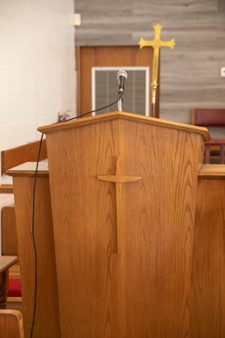
In any worship environment, delivering clear and reliable sound isn’t just important - it’s essential. From preaching sermons and leading worship music to making community announcements, having the right vocal amplification system ensures that every message is heard and felt. Among the many choices you’ll face when upgrading or installing audio in your sanctuary, one key decision stands out: whether to go with a wired setup or explore wireless microphone systems.
Both options offer distinct advantages and come with their own considerations. The best choice depends on a variety of factors, including your technical needs, budget, the layout of your space, and how your worship services typically flow. In this article, we’ll take a closer look at the pros and cons of both wired and wireless systems, helping you choose the solution that best serves your congregation’s unique needs.
Wired voice capture systems use physical cables to transmit audio signals from the sound pickup device to the mixer or amplifier. This setup has been the traditional standard for decades due to its reliability and simplicity.
Wireless systems, on the other hand, transmit sound signals through radio frequencies or digital signals. They usually consist of a transmitter (often a bodypack or handheld unit) and a receiver connected to your soundboard or amplifier.
In terms of pure signal quality and stability, wired gear tends to edge out its wireless counterpart. The direct connection from the pickup unit to the sound system ensures minimal interference, zero latency, and robust sound fidelity. Once installed, these setups are nearly immune to dropouts caused by frequency congestion or battery issues.
For sanctuaries where the sound must remain uninterrupted, such as during sermons or scripture readings - wired voice equipment offers unmatched dependability.
Advancements in digital transmission have significantly improved wireless systems. Many professional-grade units now provide excellent clarity, making them nearly indistinguishable from wired microphones in isolated testing. Moreover, church adoption is widespread: a survey noted that over 70% of churches are embracing wireless systems due to their convenience and performance
However, wireless setups still face inherent challenges. Interference from smartphones, Wi-Fi networks, or competing RF sources can cause dropouts or noise. Battery life, frequency coordination, and signal security also require ongoing attention.
This is where wireless systems truly excel. Worship leaders, pastors, and performers benefit greatly from the freedom to move without being tethered by cords. Whether walking down the aisle, leading dynamic worship, or involving multiple participants on stage, wireless voice transmission enables fluid movement and natural interaction.
In churches with modern worship formats, large choirs, or dramatic presentations, the lack of physical cabling simplifies stage design and reduces clutter. Wireless setups are also ideal for outdoor services or events that require mobile sound reinforcement.
Wired units restrict movement and can be cumbersome, especially in active worship settings. Cables must be carefully routed to prevent tripping hazards or signal disruption. That said, for more traditional services where the speaker remains stationary, such as behind a pulpit, a wired configuration might be perfectly sufficient and even preferable due to its reliability.
Installing a wired voice capture system usually requires more effort during the initial setup. Cables need to be run through walls, under carpets, or inside conduits. But once everything is in place, there’s relatively little to maintain. There's no need to monitor batteries or worry about pairing transmitters and receivers.
Wired setups are often "set and forget," making them an attractive option for churches with smaller tech teams or limited technical knowledge.
Wireless units typically require minimal physical setup. You can plug in a receiver, sync it with a transmitter, and be ready to go. This simplicity can be a major advantage in temporary setups or multi-use spaces.
However, ongoing maintenance is higher. Batteries must be recharged or replaced regularly, and systems should be tested before every use to ensure signal integrity. Frequency conflicts might need to be managed, particularly if other wireless equipment is used in the building.

Generally speaking, wired voice equipment costs less than wireless gear. You can get high-quality wired units for a fraction of the price of equivalent wireless models. Moreover, they tend to have fewer points of failure and longer life spans.
If your church is operating on a tight budget and doesn’t require much movement during services, wired solutions provide excellent value.
Wireless systems, especially those with multiple channels and high-end features, can be significantly more expensive. Factor in ongoing costs like replacement batteries or rechargeable units, and the price continues to rise.
That said, many sanctuaries consider the additional investment worthwhile for the convenience, cleaner stage design, and enhanced worship dynamics.
Since wired systems don’t rely on radio frequencies, they’re completely immune to RF interference, which can be caused by everything from smartphones to nearby broadcast equipment. Wired systems also offer better signal security, as there’s no possibility of unauthorized signal interception.
Wireless audio systems are affected by environmental factors. Urban areas with many RF sources can be particularly challenging. Security is another consideration; while many systems now offer encrypted transmission, not all models do, and cheaper units might be vulnerable to signal hijacking or eavesdropping.
Cables can disrupt the visual flow of a stage or altar. Wireless gear helps maintain a clean, minimalist appearance, which may be especially important for churches that incorporate video broadcasting or livestreaming.
That said, cable management solutions can help reduce visual clutter in wired setups, and in some architectural styles, visible cables may not be a concern at all.
Choose a Wired Setup If:
Go Wireless If:
Many modern sanctuaries benefit from a hybrid approach utilizing both wired and wireless audio solutions. For instance, a wired unit can be used for the main pulpit, while wireless gear supports musicians, readers, or guest speakers.
This strategy allows churches to balance reliability with flexibility, tailoring each component of the system to its intended use.
Selecting the right sound setup for your sanctuary is about more than just choosing between cords and transmitters. It's about creating an environment where the Word can be heard clearly, where worship can be immersive, and where technical distractions are minimized.
Take stock of your sanctuary’s unique layout, worship style, and technical capacity. Whether you go wired, wireless, or a combination of both, investing in the right voice amplification solution will support your ministry's mission and ensure every voice is heard loud and clear.